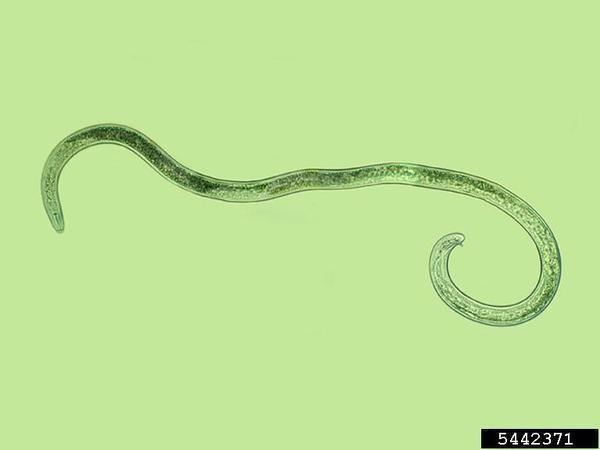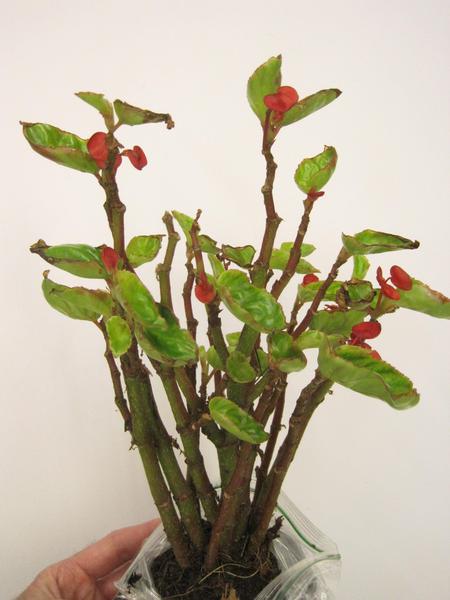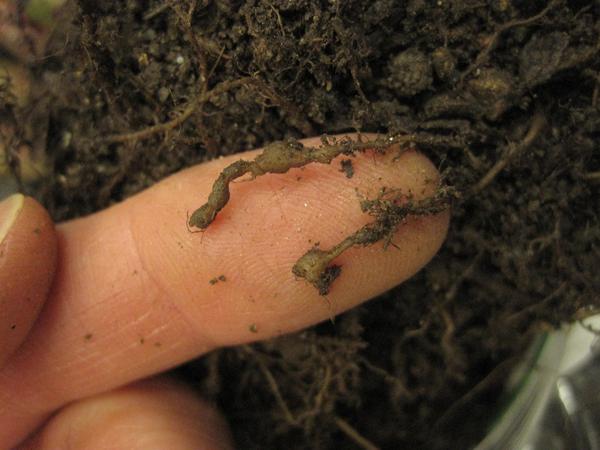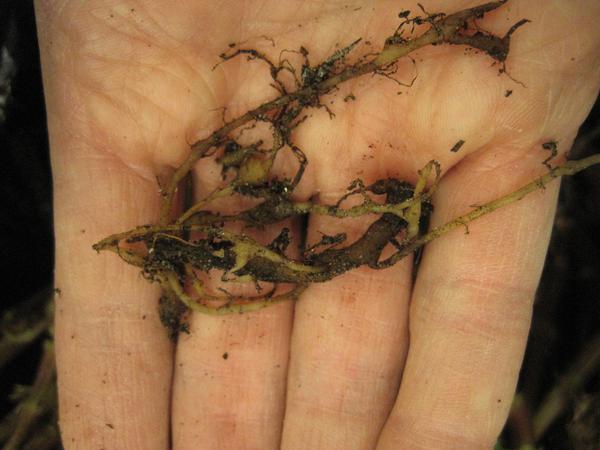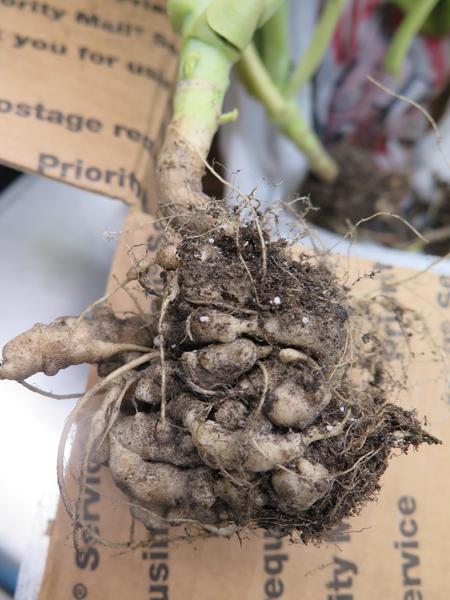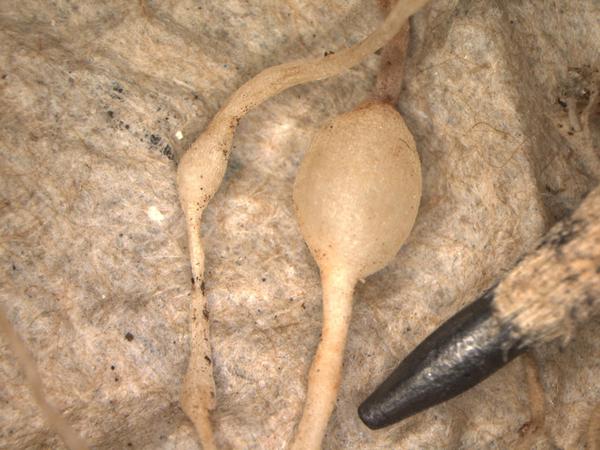Nematodes are microscopic, non-segmented roundworms. Many nematode species are found in soils, but relatively few can cause plant diseases. Root-knot nematodes (Meloidogyne spp.) (Figure 1) are the most important and most economically devastating nematodes on ornamentals. In North Carolina, southern root-knot nematode (Meloidogyne incognita) is the most common species, yet the newly emerging Meloidogyne enterolobii appears to be more aggressive on many plants, and resistance and susceptibility to M. enterolobii are likely to be different. There are many other species of plant-pathogenic nematodes, but they are less common on ornamentals in the landscape.
Symptoms
Aboveground symptoms of nematode feeding are similar to those resulting from other causes of root injury (Figure 2); therefore, it is not possible to diagnose root-knot nematode infection by aboveground symptoms alone. Depending on the host, plants affected by root-knot nematodes may lose luster, wilt, turn yellow, lose leaves, produce weak flushes of growth, have fewer and smaller leaves than healthy plants, and become stunted. The pattern of damage in the landscape will most likely be spotty since nematodes are rarely distributed evenly in the soil. While stress due to root-feeding nematodes is greatest in sandy soils, nematodes can occur in all soil types.
Root symptoms of root-knot nematode infection are distinct and can be easy to diagnose. Infection by the root-knot nematode causes gall formation, or “knots,” on roots (Figure 3 and Figure 4). Root-knot nematodes are sedentary endoparasites, so they will remain inside the root for the duration of their life once they establish a feeding site near the center of the root. Galls result from the growth of plant tissues that develop around the feeding nematodes. The nematodes secrete a plant growth hormone that stimulates cell growth, resulting in gall formation. Gall tissue is firm and solid. The galls are part of the root tissue, so removing the root-knot gall from the root is not a viable management option. Eggs are laid in gelatinous masses on the outside of the roots; the gelatinous matrix protects the eggs inside and ensures their survival over the winter.
Diagnosis
Positive identification is a critical first step in management. In the field, root-knot nematodes can usually be diagnosed by observing the symptoms described previously and by removing the plant and roots from the ground and looking for the diagnostic galls. If a nematode other than the root-knot nematode or another disease is suspected, laboratory root and soil sample analysis is necessary to identify the issue and the most effective control measures. For information and instructions on how to sample, contact your local N.C. Cooperative Extension Center or visit North Carolina State University Plant Disease and Insect Clinic.
Look-alikes. Similar swellings can develop with clubroot disease of Brassica (Figure 5) and occasionally with crown gall on woody plants such as rose. Root swellings are part of the healthy anatomy of certain ornamentals such as liriope and daylily. By comparison, nematode galls on those hosts are small (Figure 6).
Root-knot nematode infection also can be mistaken for nodules formed on the roots of legume plants due to colonization by beneficial species of Rhizobium and related genera of nitrogen-fixing bacteria. Most other natural nodules or bumps are loosely attached to roots and have hollow centers. Active Rhizobium nodules have a milky fluid in their centers and are often pale pink in color. In contrast, root-knot nematode galls have a white or gray center.
Management
Once root-knot nematode has been diagnosed, it is safe to assume that it will persist in the soil for many years. Nematode populations in the soil can fluctuate from year to year, but rarely disappear altogether.
One of the first questions raised by homeowners when told they have a nematode problem is, “What do I spray?” While several “cures” for nematode infected plants have been marketed over the years, there are no effective chemical products available to homeowners. However, the care given to ornamentals can have a substantial effect on their performance.
The main tools available for reducing the damage from root-knot nematodes are outlined below. The use of resistant plants and provision of optimal care are two of the most important management strategies. With proper care, it is possible to establish and maintain an attractive landscape, despite nematodes.
1. Prepare new planting sites properly.
Give plants the best chance to become rapidly established. Native soil in which annuals are to be planted should be prepared well, including removal of any old roots and debris from the site. Water- and nutrient-holding capacity of the soil and activity of natural enemies of nematodes are improved by incorporating organic amendments into the soil before planting. If the site has a history of nematodes or you suspect plant pathogenic nematodes are present, you can submit a soil sample to test for nematodes through the North Carolina Department of Agriculture & Consumer Services (NCDA&CS). Seek help from your county Extension center.
2. Solarize the soil.
If root-knot nematodes have accumulated to high levels on the previous year’s plant(s), soil solarization is an option to reduce the number of nematodes in your soil. Soil solarization is a nonchemical way to reduce soil pest populations, but it requires the affected area to be left bare for six to eight weeks during the hottest part of the year (summer) to be effective. Clear polyethylene may be used to cover moist soil that is well tilled and ready to be planted. The goal is to trap heat generated by sunlight inside the plastic to raise the soil temperature for a prolonged period of time to kill many nematodes, fungi, and weed seeds in the upper few inches of the bed. Solarization works best in hot climates and sandy soils. More information can be found in Soil Solarization in Tennessee: A Pesticide-Free Method for Controlling Soil-borne Pests in Home Gardens.
3. Use biological control methods.
Dense planting with certain marigold varieties for an entire season can help reduce populations of some root-knot nematode species. A few marigolds mixed in among susceptible plants will not be sufficient. For details on this practice in relation to vegetable gardens, see Nema Note 1: Root-knot Nematodes: Biocontrol with Marigolds from the NCDA&CS Agronomic Division.
4. Replace infested (contaminated) soil.
In small areas, you may remove the upper 6 to 8 inches of soil or planting mix from an annual bed and replace it with a new nematode-free planting medium. This practice does not eliminate the nematodes, but infection will be delayed until nematodes can colonize the new medium. (Plant roots can grow out of the new medium into the infested native soil and become infected.) Dispose of any removed soil in a place that will not be used for future plantings. The more soil you remove, the better hope you will have to delay new infections because nematodes can move down the soil profile to protect themselves.
5. Practice sanitation.
Remove soil from any tools and equipment (including boots) before and after working in any disease-infested landscape bed to avoid introducing root-knot nematodes or other soilborne plant pathogens into new locations. Working outside or in a well-ventilated area, use a solution of 10% household bleach to sanitize the surface of tools and equipment. Dip the tools in the solution for 5 to 10 minutes, then rinse with clean water and air-dry to eliminate living nematodes and other plant pathogens.
6. Use resistant or tolerant varieties.
The use of resistant or tolerant bedding plant varieties can be an economical way to manage root-knot nematodes. Table 1 lists annual plants from research trials at the Louisiana State University AgCenter and University of Florida that have some level of resistance to southern root-knot nematodes.
Avoid establishing highly susceptible plants in root-knot nematode infested landscape beds. In North Carolina, two bedding plants that are very susceptible to southern root-knot nematode are begonia and impatiens. While pansy is susceptible, the cool temperatures during which it is grown limit damage by root-knot nematodes.
University of Florida entomologist C.C. Goff recognized the value of knowing the relative susceptibilities of annual ornamentals nearly 60 years ago. Goff conducted field trials to study reactions of many annuals to southern root-knot nematodes over four years. Results of his tests are summarized in Table 1 and serve as a good general guide of the susceptibilities of annual ornamentals. We now know that different varieties of many species of annuals vary greatly in their reactions to root-knot nematodes, and there are additional species of root-knot nematodes that these plants were not evaluated against, so these recommendations may not apply to all growing regions. Some cultivar information is available in the reference cited in Table 1.
7. Use nematode- and disease-free transplants.
The planting site may be free of pests and diseases, but planting a nematode-infected transplant will introduce nematodes into the landscape and cause years of problems. Purchase only healthy plants, avoid the “seconds” shelves at your local garden center, and reject any plants that have evidence of nematodes or are otherwise diseased. Digging and moving plants from one landscape to another is also risky.
8. Select plants that are well adapted to the site.
Plant suitability for the location is important to maintaining plant health. Consider whether your plants are suitable for your region (climate), soil type and pH, amount of shade or sun, and drainage patterns. Plants that are “out of place” are more likely to suffer environmental stress, which can make them more susceptible to disease than well-adapted species. Moreover, a plant species that is “well adapted” to an area may be able to tolerate locally common pests.
9. Maintain plants properly.
Provide your bedding plants optimum care. Fertilize only as needed to maintain steady, healthy growth rather than encouraging excessive, succulent growth that invites attack by root-knot nematodes and other pests. Water deeply to encourage development of a deep root system that can exploit a large volume of soil for water and nutrients. Minimize stress from insects and diseases, which can make plants more susceptible to root-knot nematode infection.
10. Avoid using marketed chemical products.
There are no effective nematicides (pesticides that affect nematodes) available for homeowners, so cultural control strategies, as described previously, are important for management of this pest.
| Common Name | Scientific Name |
|---|---|
| Resistant plants1 | |
| Ageratum
|
Ageratum sp.
|
| Argemone
|
Argemone sp.
|
| Azure blue sage
|
Salvia azurea
|
| Coreopsis
|
Coreopsis lanceolata
|
| Cosmos
|
Cosmos sp.
|
| Evening primrose
|
Oenothera lamarckiana
|
| Gaillardia
|
Gaillardia sp.
|
| Gerbera daisy
|
Gerbera sp.
|
| Globe amaranth
|
Gomphrena sp.
|
| Lupine
|
Lupinus sp.
|
| Marigold, African
|
Tagetes sp.
|
| Marigold, French
|
Tagetes sp.
|
| Phlox
|
Phlox sp.
|
| Rudbeckia
|
Rudbeckia sp.
|
| Stock
|
Matthiola incana
|
| Zinnia
|
Zinnia spp.
|
| Tolerant plants2 | |
| Arctotis
|
Arctotis stoechadifolia
|
| Artemisia
|
Artemisia sacrorum viride
|
| Blue sage
|
Salvia farinacea
|
| Calliopsis
|
Coreopsis tinctoria
|
| Candytuft
|
Iberis umbellata
|
| China aster
|
Callistephus chinensis
|
| Clarkia
|
Clarkia sp.
|
| Cosmos
|
Cosmos bipinnatus
|
| Cypress vine
|
Quamoclit pennata
|
| Dianthus
|
Dianthus sp.
|
| Four-O’clock
|
Mirabilis jalapa
|
| Gerbera daisy
|
Gerbera jamesonii
|
| Globe amaranth
|
Gomphrena globosa
|
| Godetia
|
Godetia sp.
|
| Lantern groundcherry
|
Physalis franchetii
|
| Leptosyne
|
Coreopsis sp.
|
| Liatris
|
Liatris spicata
|
| Lupine
|
Lupine sp.
|
| Michaelmas daisy
|
Symphyotrichum tradescantii
|
| Mignonette
|
Reseda odorata
|
| Penstemon
|
Penstemon sp.
|
| Perennial sweet pea
|
Lathyrus latifolius
|
| Petunia
|
Petunia hybrida
|
| Phlox, big drummond
|
Phlox drummondii
|
| Phlox, dwarf
|
Phlox nana compacta
|
| Phlox, starred
|
Phlox drummondii stellaris
|
| Portulaca
|
Portulaca sp.
|
| Scarlet sage
|
Salvia splendens
|
| Shasta daisy
|
Chrysanthemum maximum
|
| Statice
|
Limonium sinuatum
|
| Stock
|
Matthoila sp.
|
| Sweet alyssum
|
Lobularia maritima
|
| Torenia, blue
|
Torenia fournieri
|
| Torenia, white
|
Torenia sp.
|
| Thunbergia
|
Thunbergia sp.
|
| Verbena
|
Verbena sp.
|
| Vinca, periwinkle
|
Catharanthus roseus
|
| Zinnia, giant
|
Zinnia elegans
|
| Zinnia, small
|
Z. elegans
|
| Moderately susceptible plants3 | |
| Acroclinium
|
Helipterum roseum
|
| Annual chrysanthemum
|
Chrysanthemum coronarium
|
| California poppy
|
Eschscholtzia californica
|
| Dimorphotheca
|
Dimorphotheca aurantiaca
|
| English daisy
|
Bellis perennis
|
| Hunnemannia
|
Hunnemannia fumariifolia
|
| Linaria
|
Linaria sp.
|
| Moonflower
|
Calonyction sp.
|
| Nicotiana
|
Nicotiana alata
|
| Perennial chrysanthemum
|
Chrysanthemum sp.
|
| Poppy
|
Papaver sp.
|
| Scarlet climber or cardinal climber
|
Quamoclit sloteri
|
| Highly susceptible plants4 | |
| Amaranthus
|
Amaranthus sp.
|
| Annual sweet pea
|
Lathyrus odoratus
|
| Baby’s breath
|
Gypsophila sp.
|
| Balsam (Impatiens)
|
Impatiens balsamina
|
| Blue lace flower (Didiscus)
|
Trachymene caerulea
|
| Butterfly flower
|
Schizanthus sp.
|
| Calendula
|
Calendula officinalis
|
| Celosia
|
Celosia argentea
|
| Coleus
|
Coleus sp.
|
| Columbine
|
Aquilegia sp.
|
| Chinese forget-me-not
|
Cynoglossum sp.
|
| Cornflower, bachelor’s button
|
Centaurea cyanus
|
| Dolichos
|
Dolichos sp.
|
| Gilia
|
Gilia sp.
|
| Gourd
|
Cucurbita sp.
|
| Helichrysum
|
Helichrysum sp.
|
| Hollyhock
|
Althea rosea
|
| Larkspur
|
Delphinium sp.
|
| Lobelia
|
Lobelia erinus
|
| Matricaria
|
Matricaria sp.
|
| Morning-glory
|
Ipomoea sp.
|
| Nasturtium
|
Tropaeolum sp.
|
| Pansy
|
Viola tricolor
|
| Snapdragon
|
Antirrhinum majus
|
| Salpiglossis
|
Salpiglossis sinuata
|
| Sunflower
|
Helianthus annuus
|
| 1Plants with no galls↵ 2Lightly infested with one or few scattered galls or a number of small galls↵ 3Moderately infested with galls more numerous or larger↵ 4Heavily infested with a large percentage of roots with large galls↵ |
|
| This list was compiled from work done by C.C. Goff and published in Nematodes of Ornamentals by Charles Overstreet, LSU Ag Extension, and Nematode Management for Bedding Plants, Extension Publication #ENY-052, by William T. Crow, University of Florida IFAS Extension. Note: Some genera appear in more than one section of the table at different susceptibility levels as some species within genera may be susceptible to southern root-knot nematodes. | |
Resources
- Your local N.C. Cooperative Extension center
- NC State University Plant Disease and Insect Clinic (diagnostics and control recommendations)
- NC State Extension Plant Pathology page (information on crop disease management)
Acknowledgments
The authors want to thank Michael Munster, Marisol Quintanilla, and Fulya Baysal-Gurel for providing feedback and suggestions for improving this publication.
Publication date: June 22, 2020
AG-880
N.C. Cooperative Extension prohibits discrimination and harassment regardless of age, color, disability, family and marital status, gender identity, national origin, political beliefs, race, religion, sex (including pregnancy), sexual orientation and veteran status.

